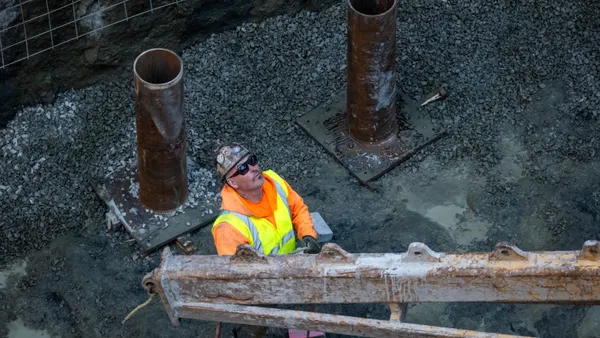Dive Brief:
- The Associated General Contractors of America and Autodesk recently released a survey of more than 2,500 construction professionals in which 80% indicated they are having a tough time filling hourly craft positions. In addition, 81% of construction firms said it will continue to be hard — or get harder — to find craft workers this year.
- The labor shortage, which AGC chief economist Ken Simonson described as “significant and widespread,” has caused companies to increase pay, benefits and training in an effort to attract more workers. Nearly half of firms that responded to the survey indicated it's taking them longer to complete projects and that their bid prices are higher because of higher than anticipated costs.
- Some companies, the survey found, are introducing new technology such as virtual construction, offsite prefabrication, BIM, drones, GPS, laser-guided equipment and 3D printing to help ease labor shortages.
Dive Insight:
Sarah Hodges, senior director of the construction business line at Autodesk, said in a webinar introducing the survey findings that “This survey is a call to action for the industry at large. It outlines there’s clearly a need, clearly there are jobs and clearly the time to act is now. The industry is at a tipping point.”
With the world's population expected to reach 9.7 billion by 2050, Hodges said, building has to change in fundamental ways. Up to 13,000 new buildings need to be erected per day to meet the needs of the growing population.
Hodges believes technology is one avenue to address the labor shortage and help achieve the necessary building growth. Tech enables connectivity between the jobsite and back office like never before, she said, as well as changing how information is collected and analyzed, both of which can drive increased efficiencies.
Autodesk is trying to arm students, of which she sees an influx of in the industry, and craft workers with technology, Hodges said, not only to automate parts of the process, but also to enhance problem-solving.
“Construction is not a dangerous, dead-end career,” Simonson said. “It provides great opportunity to use tools and technologies of many kinds.”
Brian Turmail, senior executive director of public affairs at AGC, agrees tech is a changing the landscape, citing its increasing availability, affordability and, most importantly, adaptability. “We’re seeing smarter technology, such as a robot that can handle a slightly crooked screw, whereas before it couldn’t,” he said. “We as an association need to spend more time and energy about how to teach firms to take advantage of technology. We think the project site 10 years from now will look very different than it does today."
Dan Gilbane, senior vice president of Gilbane Building Co.’s southwest division, describes this as a “rare time in the construction industry” where most geographies and market sectors are in growth mode. Gilbane sees a tremendous opportunity to leverage technology, including the use of drones, 3D printing and virtual environments. Using such technologies, which appeal to Gilbane’s young workers, has made a “huge impact on our business not only from attracting and retaining talent, but also by accelerating productivity,” he said.
In addition to the survey findings, AGC announced it retooled its workforce development plan introduced five years ago that lists steps federal officials should take to support construction workforce development. In late July, Congress passed and President Trump signed into law the Strengthening Career and Technical Education for the 21st Century Act, part of which reauthorized the Carl D. Perkins Vocational and Technical Education Act, boosting funding for construction-focused programs and career pathways.
“More work needs to be done, though,” said Simonson. “Solving the chronic workforce shortages will require active support from all levels of government.”
Updated recommendations include doubling funding for career and technical education throughout a five-year span, as well as allowing more immigrants with construction skills to legally enter the country. AGC also is launching a targeted digital ad recruiting campaign and establishing a workforce venture fund.
“The plan serves as a guide to let each player know what they can and should do to prepare the next generation of construction workers,” Simonson said.












